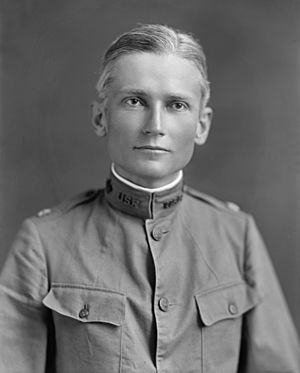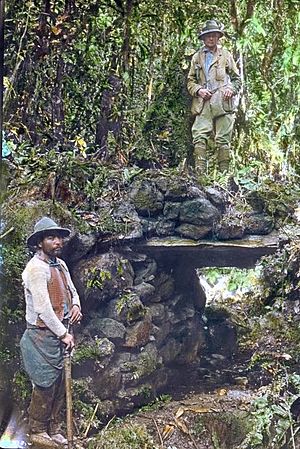Hiram Bingham III facts for kids
Quick facts for kids
Hiram Bingham III
|
|
|---|---|
 |
|
| United States Senator from Connecticut |
|
| In office January 8, 1925 – March 3, 1933 |
|
| Preceded by | Frank Bosworth Brandegee |
| Succeeded by | Augustine Lonergan |
| 69th Governor of Connecticut | |
| In office January 7, 1925 – January 8, 1925 |
|
| Lieutenant | John H. Trumbull |
| Preceded by | Charles A. Templeton |
| Succeeded by | John H. Trumbull |
| 58th Lieutenant Governor of Connecticut | |
| In office 1923–1925 |
|
| Governor | Charles A. Templeton |
| Preceded by | Charles A. Templeton |
| Succeeded by | John H. Trumbull |
| Personal details | |
| Born | November 19, 1875 Honolulu, Kingdom of Hawaii |
| Died | June 6, 1956 (aged 80) Washington, D.C. |
| Nationality | American |
| Political party | Republican |
| Spouse(s) | 1) Alfreda Mitchell (div.) 2) Suzanne Carroll Hill |
| Children | Jonathan Brewster Bingham Hiram Bingham IV Charles Tiffany Bingham Brewster Bingham Mitchell Bingham Woodbridge Bingham Alfred Mitchell Bingham |
| Alma mater | Yale University University of California-Berkeley Harvard University |
| Military service | |
| Branch/service | United States National Guard United States Army Signal Corps Aviation Section United States Army Air Service |
| Rank | Captain Lieutenant Colonel |
Hiram Bingham III (born November 19, 1875 – died June 6, 1956) was an American expert, explorer, and politician. He is best known for making the ancient Inca city of Machu Picchu known to the world in 1911. Local farmers helped guide him to the site. Later in his life, Bingham became a U.S. Senator for the state of Connecticut.
Contents
Early Life and Education
Hiram Bingham III was born in Honolulu, Hawaii, on November 19, 1875. His father, Hiram Bingham II, and his grandparents, Hiram Bingham I and Sybil Moseley Bingham, were all early Protestant missionaries in Hawaii.
Hiram attended O'ahu College, now called Punahou School, from 1882 to 1892. He then moved to the United States to finish his schooling. He graduated from Phillips Academy in Massachusetts in 1894.
Bingham earned several college degrees. He received a Bachelor of Arts from Yale College in 1898. He also earned a degree from the University of California, Berkeley in 1900. There, he took one of the first courses in U.S. history about Latin America. In 1905, he earned his Ph.D. from Harvard University.
After his studies, Bingham taught history and politics at Harvard. He also worked at Princeton University under Woodrow Wilson, who later became president. In 1907, he became a lecturer in South American history at Yale. Bingham was a pioneer in teaching and researching Latin American history in the U.S.
Explorer and Discoverer of Machu Picchu

Hiram Bingham was not a trained archaeologist. However, during his time as a professor at Yale, he rediscovered the Inca city of Machu Picchu. In 1908, he traveled to Peru. A local leader convinced him to visit the ancient city of Choquequirao. Bingham wrote about this trip in his book, Across South America.
Bingham was very excited by the idea of finding more unexplored Inca cities. He organized the 1911 Yale Peruvian Expedition. One main goal was to find the last capital of the Incas. With help from local guides, he found and correctly identified Vitcos and Vilcabamba. However, he did not realize Vilcabamba was the last capital. Instead, he continued on and mistakenly thought Machu Picchu was the "Lost City of the Incas." Years later, another explorer, Vince Lee, proved that Vilcabamba was indeed the Incas' last capital.
On July 24, 1911, a local farmer named Melchor Arteaga led Bingham to Machu Picchu. The site had been mostly forgotten by people outside the local valley. Some people believe other explorers had seen the ruins before Bingham, including local missionaries and explorers from Cusco.
Bingham returned to Peru in 1912, 1914, and 1915. He had support from Yale and the National Geographic Society. In his 1948 book, The Lost City of the Incas, Bingham wrote that he believed Machu Picchu was a major religious site. Modern research now suggests it was a royal estate where Inca leaders stayed during the summer.
Machu Picchu has become one of the most popular tourist spots in South America. Bingham is recognized for bringing the site to the world's attention. The road that takes tourist buses to the site is named the Hiram Bingham Highway.
Some people believe Bingham was a possible inspiration for the famous movie character Indiana Jones. His book Lost City of the Incas became a bestseller.
Peru has asked for the return of many artifacts that Bingham took from Machu Picchu. These include mummies, pottery, and bones. In 2007, Yale University and the Peruvian government agreed to return these items.
Who Saw Machu Picchu First?
After Bingham announced his discovery of Machu Picchu, others claimed they had seen the city first. These included a British missionary named Thomas Payne and a German engineer named J. M. von Hassel. Recent findings suggest a German man named Augusto Berns bought land near Machu Picchu in the 1860s. An 1874 map even shows the site of Machu Picchu.
Family Life

Hiram Bingham married Alfreda Mitchell on November 20, 1900. Alfreda was the granddaughter of Charles Lewis Tiffany, who founded Tiffany & Co. They had seven sons:
- Woodbridge Bingham (1901–1986), a professor.
- Hiram Bingham IV (1903–1988), a diplomat and World War II hero.
- Alfred Mitchell Bingham (1905–1998), a lawyer and author.
- Charles Tiffany Bingham (1906–1993), a doctor.
- Brewster Bingham (1908–1995), a minister.
- Mitchell Bingham (1910–1994), an artist.
- Jonathan Brewster Bingham (1914–1986), a U.S. Congressman.
After divorcing Alfreda, he married Suzanne Carroll Hill in June 1937.
Military Service
In 1916, Bingham became a captain in the Connecticut National Guard. In 1917, he became an aviator. He helped create the United States Schools of Military Aeronautics. These schools trained aviation cadets on the ground.
He served in the Aviation Section, U.S. Signal Corps and later the United States Army Air Service. He reached the rank of lieutenant colonel. In France, Bingham commanded the Third Aviation Instruction Center. This was the Air Service's largest training school. After the war, he supported the Air Service's goal to become a separate branch of the military. He wrote about his wartime experiences in his book, An Explorer in the Air Service.
Political Career
In 1922, Bingham was elected lieutenant governor of Connecticut. He held this job until 1924. In November 1924, he was elected governor of Connecticut. On December 16, 1924, Bingham was also elected as a Republican to the United States Senate.
Because he was elected to both roles, Bingham served as governor for only one day. This is the shortest term of any Connecticut governor. He was then reelected to a full six-year term in the Senate in 1926.
In the Senate, Bingham led the Committee on Printing and later the Committee on Territories and Insular Possessions. President Calvin Coolidge appointed him to the President's Aircraft Board. The press called him "The Flying Senator."
Bingham lost his bid for reelection in 1932. This was during the Great Depression, which led to many Democrats winning elections. He left the Senate in 1933.
During World War II, Bingham taught at several U.S. Navy training schools. In 1951, he became Chairman of the Civil Service Commission Loyalty Review Board, serving until 1953.
Senate Censure
In 1929, the Senate investigated an issue involving Bingham. He had an unusual arrangement with his clerk and a lobbyist. Bingham paid his clerk's salary to the lobbyist. This allowed the lobbyist to attend closed meetings of the Finance Committee, pretending to be a Senate staffer.
The Senate decided that Bingham's actions were not proper. On November 4, 1929, the Senate voted to officially disapprove of his conduct. This is called a censure.
Death
Hiram Bingham III passed away on June 6, 1956, at his home in Washington, D.C. He was buried at Arlington National Cemetery in Virginia.
See also
 In Spanish: Hiram Bingham III para niños
In Spanish: Hiram Bingham III para niños


